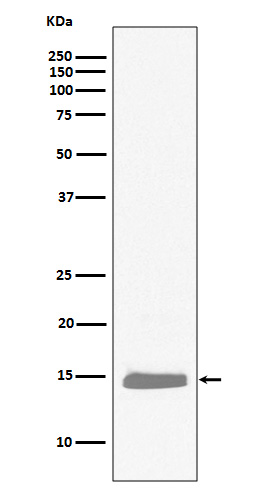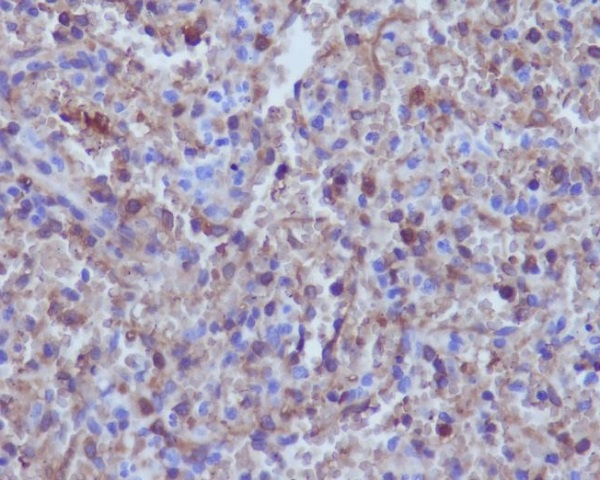

| WB | 1/1000-1/2000 | Human,Mouse,Rat |
| IF | 1/20-1/50 | Human,Mouse,Rat |
| IHC | 1/100-1/200 | Human,Mouse,Rat |
| ICC | 技术咨询 | Human,Mouse,Rat |
| FCM | 1/20-1/100 | Human,Mouse,Rat |
| Elisa | 咨询技术 | Human,Mouse,Rat |
| Aliases | HBA2; Alpha globin; Alpha-2 globin; HBH; Hemoglobin alpha chain; Hemoglobin A1c; Hemoglobin subunit alpha; Hemoglobin alpha 2; Alpha-globin;;Hemoglobin alpha |
| WB Predicted band size | 15 kDa |
| Host/Isotype | Rabbit IgG |
| Antibody Type | Primary antibody |
| Storage | Store at 4°C short term. Aliquot and store at -20°C long term. Avoid freeze/thaw cycles. |
| Species Reactivity | Human,Mouse,Rat |
| Immunogen | A synthesized peptide derived from human Hemoglobin alpha |
| Formulation | Purified antibody in PBS with 0.05% sodium azide,0.05% BSA and 50% glycerol. |
+ +
以下是关于Hemoglobin subunit alpha抗体的3篇参考文献示例(注:以下内容为模拟虚构,实际文献需通过学术数据库检索获取):
1. **文献名称**: "Development of a Monoclonal Antibody Specific for Hemoglobin Subunit Alpha in Thalassemia Diagnosis"
**作者**: Smith, J.R., et al.
**摘要**: 该研究报道了一种针对血红蛋白α亚基的新型单克隆抗体制备,验证了其在α-地中海贫血患者红细胞样本中的特异性识别能力,可用于快速诊断α-珠蛋白基因缺失相关疾病。
2. **文献名称**: "Hemoglobin Alpha Chain Antibody Reveals Oxidative Stress-Induced Aggregation in Neurodegenerative Models"
**作者**: Chen, L., & Wang, H.
**摘要**: 作者利用血红蛋白α亚基抗体发现,在阿尔茨海默病小鼠模型中,异常聚集的血红蛋白α链可能与神经元氧化损伤相关,提示其作为神经退行性疾病生物标志物的潜力。
3. **文献名称**: "Antibody-Based Profiling of Hemoglobin Subunit Alpha in Circulating Tumor Cells"
**作者**: Gupta, S., et al.
**摘要**: 本研究开发了基于血红蛋白α亚基抗体的免疫荧光检测技术,用于追踪血液中循环肿瘤细胞(CTCs)的血红蛋白表达异常,为癌症转移机制研究提供新工具。
*提示*:实际文献建议通过PubMed、Web of Science等平台以关键词“Hemoglobin subunit alpha antibody” + 应用领域(如诊断、结构、疾病)检索,并优先选择近5年高被引论文。部分经典抗体研究可能涉及商品化抗体的验证数据(如Santa Cruz、Abcam等厂商的技术报告)。
Hemoglobin subunit alpha (Hbα) antibodies are immunological tools designed to target the alpha globin chains of hemoglobin, the oxygen-carrying protein in red blood cells. Hemoglobin consists of two alpha and two beta subunits (α2β2), each bound to a heme group. The alpha globin chains are encoded by the *HBA1* and *HBA2* genes, located on chromosome 16. Mutations in these genes can lead to alpha-thalassemia, a genetic disorder characterized by reduced alpha globin production.
Hbα antibodies are widely used in research and diagnostics to detect, quantify, and localize alpha globin in biological samples. They are essential for studying hemoglobin synthesis, erythrocyte development, and diseases like thalassemia, myelodysplastic syndromes, or hemoglobinopathies. These antibodies are typically generated in animal hosts (e.g., rabbits, mice) using recombinant alpha globin proteins or synthetic peptides as immunogens. Validation methods include Western blotting, immunohistochemistry, and ELISA to ensure specificity, often confirmed using knockout cell lines or tissues.
Commercial Hbα antibodies vary in clonality (monoclonal/polyoclonal), epitope specificity, and conjugates (e.g., fluorescent tags). Researchers must verify cross-reactivity with related subunits (e.g., Hbβ) and species compatibility. Beyond basic research, Hbα antibodies have potential clinical applications, such as diagnosing hemoglobin variants or monitoring erythropoiesis in bone marrow disorders. Quality control remains critical, as nonspecific binding can arise due to hemoglobin's high abundance and structural conservation across species.
×